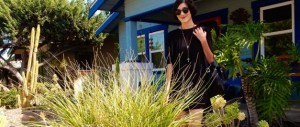[Editor’s note: This was originally published as a guest blog for the Melbourne Writers Festival.]
 It’s midnight and I’ve been in transit for about 36 hours when I’m met at San Diego airport by Rebecca Moore and Fielding ‘Mac’ McGehee, a couple in their sixties who I’ve been corresponding with for several months. The past day-and-a-half has been a medley of vaguely disorienting experiences—I’ve been badgered by a Honolulu customs official, stumbled upon a plaza of hula-dancing Japanese tourists, and slept for eleven hours straight. After all this, I’m anxious for something familiar, and Becky and Mac are exactly that. They’re also the founders and directors of the Jonestown Institute.
It’s midnight and I’ve been in transit for about 36 hours when I’m met at San Diego airport by Rebecca Moore and Fielding ‘Mac’ McGehee, a couple in their sixties who I’ve been corresponding with for several months. The past day-and-a-half has been a medley of vaguely disorienting experiences—I’ve been badgered by a Honolulu customs official, stumbled upon a plaza of hula-dancing Japanese tourists, and slept for eleven hours straight. After all this, I’m anxious for something familiar, and Becky and Mac are exactly that. They’re also the founders and directors of the Jonestown Institute.
‘Jonestown’ isn’t a name that means much to most Australians under thirty, probably because it refers to an event that happened before we were born—the mass-murder suicide of 900 Americans in the remote jungle settlement of Jonestown, Guyana. Yet for over a year, I’ve been reading up on it, bombarding my boyfriend with trivia about it, and making notes for a novel about the people and times that gave rise to it (working title: Beautiful Revolutionary). Now I’ve taken my research to America.
On my first morning at the Jonestown Institute—aka, Becky and Mac’s bright blue Craftsman-style home—they sit me down and ask what they can do to make my weekend here as rewarding as possible. I’m shy and tongue-tied. Later, Becky takes me to Lomaland, a glittering oceanside former New Age commune. Becky is a Religious Studies scholar with a special interest in new religious movements, which extends to Peoples Temple, the movement that resulted in Jonestown. Yet her investment is also personal. She lost two sisters in Jonestown, one of whom was the longtime mistress of Peoples Temple leader Jim Jones and is the inspiration for my novel’s protagonist.
I’m keen to hear Becky talk about her sister Carolyn all weekend, without really knowing what to ask. The subject hovers on my lips until Sunday evening, when I come up with some “Carolyn questions”. Afterward, we commemorate my last night in San Diego with a viewing of The Sacrament—a Jonestown-inspired B-movie featuring a cocaine-snorting cult leader and vatfuls of orange Kool-Aid/ blood. When I ask my hosts if they’re ever offended by all the bad Jonestown pop culture out there, they laugh and tell me, “We used to be. Now we just expect the worst and are pleasantly surprised when they get anything right.”
Getting it completely right is a formidable and perhaps impossible task when it comes to writing about something as controversial as Jonestown. I’m all the more aware of this as I notice Becky bristling at my praise of certain Jonestown books that she finds skewed. But the general feeling I get from my hosts is one of encouragement. What they seem to value most isn’t a slavish adherence to facts so much as openmindedness and an understanding that there’s more to Jonestown than dead bodies—or, as I’m told on my tour of the Peoples Temple special collection at SDSU, “There was life there. These people were building something.”
On Monday morning, Mac returns me to the airport with a cute little packed lunch, like it’s my first day of school. I’ve got the same sad butterfly feeling I had leaving my mum a couple of days earlier, only worse; I’ll be seeing Mum again soon, but I don’t know when I’ll next see Becky and Mac, who’ve told me I can think of them as my “America parents”. Yet Indiana awaits—home state of Jim Jones and Peoples Temple—and, after that, a month of meeting contacts and scouring the Peoples Temple archives in San Francisco. My Jonestown education has officially begun.